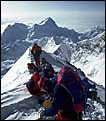
Just the Facts
![]()
The concentration (percentage) of oxygen in the air is the same at all
altitudes.
The amount of oxygen available to the human body is determined by atmospheric pressure which decreases with altitude -- the air thins leaving fewer molecules of oxygen per breath.
Atmospheric pressure determines how much air is "pushed" into the lungs with each breath.
The atmospheric pressure at the summit of Mount Everest (29,028') is about a third that at sea level.
Heart beat rate, breathing rate, and the production of red blood cells, which carry oxygen throughout the body, increases as the body acclimates to high altitude allowing more oxygen to be "grabbed" from every breath.
![]()
Acute Mountain Sickness (AMS)
![]()
Often occurs around 8,000'
Symptoms:
This may be a warning sign for the onset of more serious altitude illness.
Treatment is rest with further ascent recommended only after symptoms have ceased.
![]()
Severe AMS
![]()
Further ascent is not recommended unless there are options for easy and rapid descent should symptoms recur.
![]()
HACE Symptoms
![]()
Has occurred as low as 10,000'
Coma and death may rapidly follow. The only treatment is immediate descent.
![]()
HAPE Symptoms
![]()
Rarely occurs below 8,000'
Death can come on quickly. The only treatment is immediate descent.
![]()
Acclimating
![]()
![]()
Facts taken from Stephen Bezrucha's "Altitude Sickness: Prevention
and Treatment," with permission from The Mountaineers, Seattle, WA